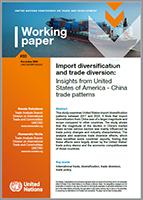
This study examines United States import diversification patterns between 2017 and 2022. It finds that import diversification from China was of a larger magnitude and scope compared to other countries. The study shows that the magnitude of the decline in China's market share across various sectors was mainly influenced by trade policy changes and industry characteristics.
The analysis also examines trade diversion effects, which have benefited some countries' exports, finding that these effects were largely driven by the United States' trade policy stance and the economic competitiveness of those countries.
In recent years, geopolitical tensions, trade disputes, logistics challenges, and global pandemics have fuelled discussions on supply chain resilience. A common narrative arising from these events has been the need to mitigate risks stemming from potential trade policy changes and supply chain disruptions.
A substantial part of this narrative has focused on the United States of America and China because of their strong trade relationship, shifts in their trade policy stance1, and supply diversification strategies.
The substantial change in United States import patterns from China provides a valuable opportunity to examine the outcomes and drivers of supply diversification strategies. This analysis is important for both policymakers and businesses, offering empirical insights into how global trade relationships are evolving.
In exploring the patterns and effects of United States supply diversification, this paper investigates three related issues.
- First, it examines whether recent changes in United States import patterns have been driven by the general objective to reduce risks from limited supply diversification or whether these changes primarily stem from reducing imports from China.
- Second, by analyzing industry-specific changes, the paper identifies possible determinants of Chinaa's loss in market share.
- Third, it expands on the literature regarding trade diversion effects, providing additional insights into the factors that may have allowed third countries to benefit from China's reduced presence in the United States market.
This paper is part of the literature examining the trade effects originating from the additional tariffs the United States and China imposed on each other during 2018 and 2019.
The paper is structured as follows:
Section 2 describes the data and provides some definitions.
Section 3 presents descriptive statistics on United States import diversification patterns between 2017 and 2022.
Section 4 uses econometric methods to provide estimates on the patterns and determinants of United States import diversification.
Section 5 identifies countries that have benefited from trade diversion effects and explores some of the determinants of such gains.
Section 6 concludes.
The findings, interpretations and conclusions expressed herein are those of the author(s) and do not necessarily reflect the views of the United Nations or its officials or Member States. The designations employed and the presentation of material on any map in this work do not imply the expression of any opinion whatsoever on the part of the United Nations concerning the legal status of any country, territory, city, or area or of its authorities, or concerning the delimitation of its frontiers and boundaries. This paper has not been formally edited.


